Qingfu Zhang
CUHK
Provable Benefit of Curriculum in Transformer Tree-Reasoning Post-Training
Nov 10, 2025Abstract:Recent curriculum techniques in the post-training stage of LLMs have been widely observed to outperform non-curriculum approaches in enhancing reasoning performance, yet a principled understanding of why and to what extent they work remains elusive. To address this gap, we develop a theoretical framework grounded in the intuition that progressively learning through manageable steps is more efficient than directly tackling a hard reasoning task, provided each stage stays within the model's effective competence. Under mild complexity conditions linking consecutive curriculum stages, we show that curriculum post-training avoids the exponential complexity bottleneck. To substantiate this result, drawing insights from the Chain-of-Thoughts (CoTs) solving mathematical problems such as Countdown and parity, we model CoT generation as a states-conditioned autoregressive reasoning tree, define a uniform-branching base model to capture pretrained behavior, and formalize curriculum stages as either depth-increasing (longer reasoning chains) or hint-decreasing (shorter prefixes) subtasks. Our analysis shows that, under outcome-only reward signals, reinforcement learning finetuning achieves high accuracy with polynomial sample complexity, whereas direct learning suffers from an exponential bottleneck. We further establish analogous guarantees for test-time scaling, where curriculum-aware querying reduces both reward oracle calls and sampling cost from exponential to polynomial order.
Consistency Is Not Always Correct: Towards Understanding the Role of Exploration in Post-Training Reasoning
Nov 10, 2025Abstract:Foundation models exhibit broad knowledge but limited task-specific reasoning, motivating post-training strategies such as RLVR and inference scaling with outcome or process reward models (ORM/PRM). While recent work highlights the role of exploration and entropy stability in improving pass@K, empirical evidence points to a paradox: RLVR and ORM/PRM typically reinforce existing tree-like reasoning paths rather than expanding the reasoning scope, raising the question of why exploration helps at all if no new patterns emerge. To reconcile this paradox, we adopt the perspective of Kim et al. (2025), viewing easy (e.g., simplifying a fraction) versus hard (e.g., discovering a symmetry) reasoning steps as low- versus high-probability Markov transitions, and formalize post-training dynamics through Multi-task Tree-structured Markov Chains (TMC). In this tractable model, pretraining corresponds to tree expansion, while post-training corresponds to chain-of-thought reweighting. We show that several phenomena recently observed in empirical studies arise naturally in this setting: (1) RLVR induces a squeezing effect, reducing reasoning entropy and forgetting some correct paths; (2) population rewards of ORM/PRM encourage consistency rather than accuracy, thereby favoring common patterns; and (3) certain rare, high-uncertainty reasoning paths by the base model are responsible for solving hard problem instances. Together, these explain why exploration -- even when confined to the base model's reasoning scope -- remains essential: it preserves access to rare but crucial reasoning traces needed for difficult cases, which are squeezed out by RLVR or unfavored by inference scaling. Building on this, we further show that exploration strategies such as rejecting easy instances and KL regularization help preserve rare reasoning traces. Empirical simulations corroborate our theoretical results.
Beyond the Lower Bound: Bridging Regret Minimization and Best Arm Identification in Lexicographic Bandits
Nov 08, 2025Abstract:In multi-objective decision-making with hierarchical preferences, lexicographic bandits provide a natural framework for optimizing multiple objectives in a prioritized order. In this setting, a learner repeatedly selects arms and observes reward vectors, aiming to maximize the reward for the highest-priority objective, then the next, and so on. While previous studies have primarily focused on regret minimization, this work bridges the gap between \textit{regret minimization} and \textit{best arm identification} under lexicographic preferences. We propose two elimination-based algorithms to address this joint objective. The first algorithm eliminates suboptimal arms sequentially, layer by layer, in accordance with the objective priorities, and achieves sample complexity and regret bounds comparable to those of the best single-objective algorithms. The second algorithm simultaneously leverages reward information from all objectives in each round, effectively exploiting cross-objective dependencies. Remarkably, it outperforms the known lower bound for the single-objective bandit problem, highlighting the benefit of cross-objective information sharing in the multi-objective setting. Empirical results further validate their superior performance over baselines.
Parametric Pareto Set Learning for Expensive Multi-Objective Optimization
Nov 08, 2025Abstract:Parametric multi-objective optimization (PMO) addresses the challenge of solving an infinite family of multi-objective optimization problems, where optimal solutions must adapt to varying parameters. Traditional methods require re-execution for each parameter configuration, leading to prohibitive costs when objective evaluations are computationally expensive. To address this issue, we propose Parametric Pareto Set Learning with multi-objective Bayesian Optimization (PPSL-MOBO), a novel framework that learns a unified mapping from both preferences and parameters to Pareto-optimal solutions. PPSL-MOBO leverages a hypernetwork with Low-Rank Adaptation (LoRA) to efficiently capture parametric variations, while integrating Gaussian process surrogates and hypervolume-based acquisition to minimize expensive function evaluations. We demonstrate PPSL-MOBO's effectiveness on two challenging applications: multi-objective optimization with shared components, where certain design variables must be identical across solution families due to modular constraints, and dynamic multi-objective optimization, where objectives evolve over time. Unlike existing methods that cannot directly solve PMO problems in a unified manner, PPSL-MOBO learns a single model that generalizes across the entire parameter space. By enabling instant inference of Pareto sets for new parameter values without retraining, PPSL-MOBO provides an efficient solution for expensive PMO problems.
Quantization Meets dLLMs: A Systematic Study of Post-training Quantization for Diffusion LLMs
Aug 20, 2025Abstract:Recent advances in diffusion large language models (dLLMs) have introduced a promising alternative to autoregressive (AR) LLMs for natural language generation tasks, leveraging full attention and denoising-based decoding strategies. However, the deployment of these models on edge devices remains challenging due to their massive parameter scale and high resource demands. While post-training quantization (PTQ) has emerged as a widely adopted technique for compressing AR LLMs, its applicability to dLLMs remains largely unexplored. In this work, we present the first systematic study on quantizing diffusion-based language models. We begin by identifying the presence of activation outliers, characterized by abnormally large activation values that dominate the dynamic range. These outliers pose a key challenge to low-bit quantization, as they make it difficult to preserve precision for the majority of values. More importantly, we implement state-of-the-art PTQ methods and conduct a comprehensive evaluation across multiple task types and model variants. Our analysis is structured along four key dimensions: bit-width, quantization method, task category, and model type. Through this multi-perspective evaluation, we offer practical insights into the quantization behavior of dLLMs under different configurations. We hope our findings provide a foundation for future research in efficient dLLM deployment. All codes and experimental setups will be released to support the community.
Discovering Interpretable Programmatic Policies via Multimodal LLM-assisted Evolutionary Search
Aug 07, 2025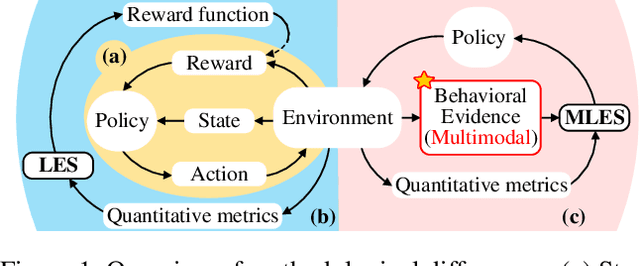
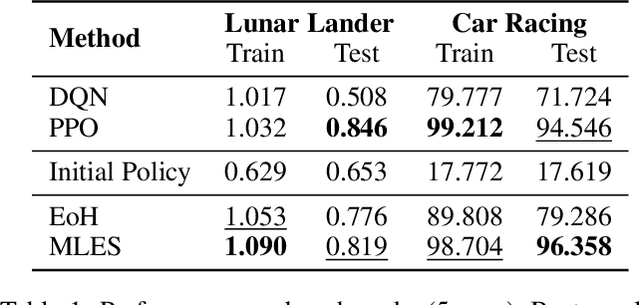
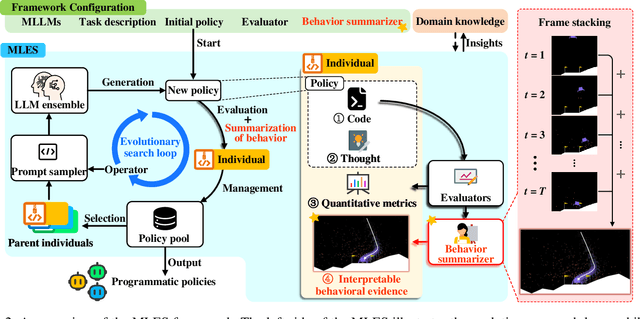
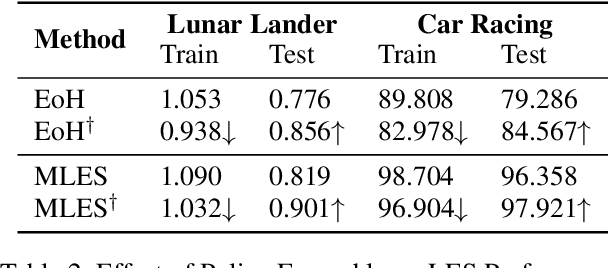
Abstract:Interpretability and high performance are essential goals in designing control policies, particularly for safety-critical tasks. Deep reinforcement learning has greatly enhanced performance, yet its inherent lack of interpretability often undermines trust and hinders real-world deployment. This work addresses these dual challenges by introducing a novel approach for programmatic policy discovery, called Multimodal Large Language Model-assisted Evolutionary Search (MLES). MLES utilizes multimodal large language models as policy generators, combining them with evolutionary mechanisms for automatic policy optimization. It integrates visual feedback-driven behavior analysis within the policy generation process to identify failure patterns and facilitate targeted improvements, enhancing the efficiency of policy discovery and producing adaptable, human-aligned policies. Experimental results show that MLES achieves policy discovery capabilities and efficiency comparable to Proximal Policy Optimization (PPO) across two control tasks, while offering transparent control logic and traceable design processes. This paradigm overcomes the limitations of predefined domain-specific languages, facilitates knowledge transfer and reuse, and is scalable across various control tasks. MLES shows promise as a leading approach for the next generation of interpretable control policy discovery.
Learning to Insert for Constructive Neural Vehicle Routing Solver
May 20, 2025



Abstract:Neural Combinatorial Optimisation (NCO) is a promising learning-based approach for solving Vehicle Routing Problems (VRPs) without extensive manual design. While existing constructive NCO methods typically follow an appending-based paradigm that sequentially adds unvisited nodes to partial solutions, this rigid approach often leads to suboptimal results. To overcome this limitation, we explore the idea of insertion-based paradigm and propose Learning to Construct with Insertion-based Paradigm (L2C-Insert), a novel learning-based method for constructive NCO. Unlike traditional approaches, L2C-Insert builds solutions by strategically inserting unvisited nodes at any valid position in the current partial solution, which can significantly enhance the flexibility and solution quality. The proposed framework introduces three key components: a novel model architecture for precise insertion position prediction, an efficient training scheme for model optimization, and an advanced inference technique that fully exploits the insertion paradigm's flexibility. Extensive experiments on both synthetic and real-world instances of the Travelling Salesman Problem (TSP) and Capacitated Vehicle Routing Problem (CVRP) demonstrate that L2C-Insert consistently achieves superior performance across various problem sizes.
TokLIP: Marry Visual Tokens to CLIP for Multimodal Comprehension and Generation
May 08, 2025Abstract:Pioneering token-based works such as Chameleon and Emu3 have established a foundation for multimodal unification but face challenges of high training computational overhead and limited comprehension performance due to a lack of high-level semantics. In this paper, we introduce TokLIP, a visual tokenizer that enhances comprehension by semanticizing vector-quantized (VQ) tokens and incorporating CLIP-level semantics while enabling end-to-end multimodal autoregressive training with standard VQ tokens. TokLIP integrates a low-level discrete VQ tokenizer with a ViT-based token encoder to capture high-level continuous semantics. Unlike previous approaches (e.g., VILA-U) that discretize high-level features, TokLIP disentangles training objectives for comprehension and generation, allowing the direct application of advanced VQ tokenizers without the need for tailored quantization operations. Our empirical results demonstrate that TokLIP achieves exceptional data efficiency, empowering visual tokens with high-level semantic understanding while enhancing low-level generative capacity, making it well-suited for autoregressive Transformers in both comprehension and generation tasks. The code and models are available at https://github.com/TencentARC/TokLIP.
Fitness Landscape of Large Language Model-Assisted Automated Algorithm Search
May 01, 2025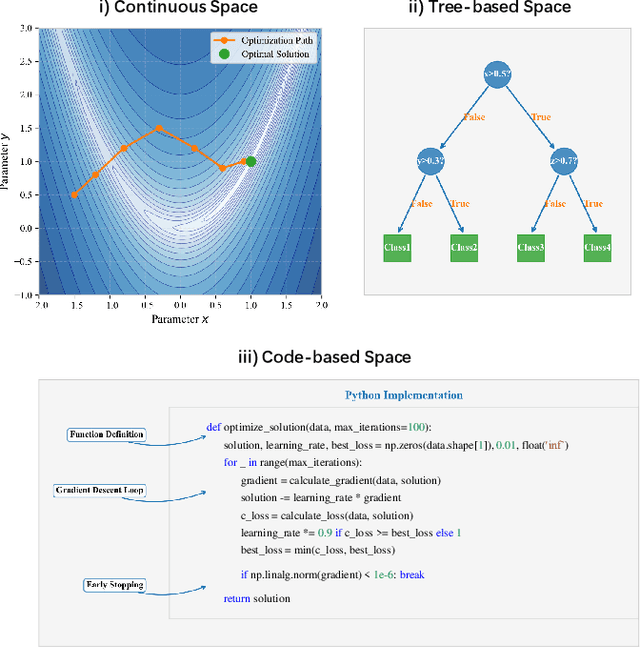
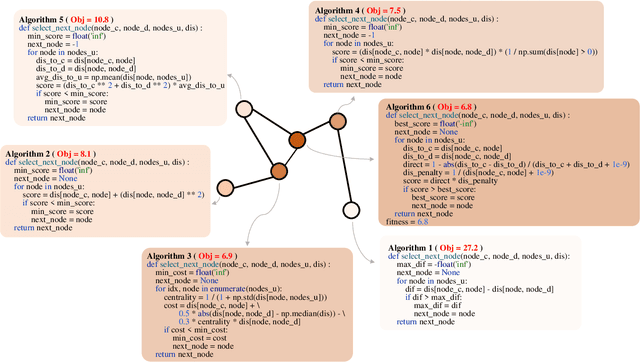
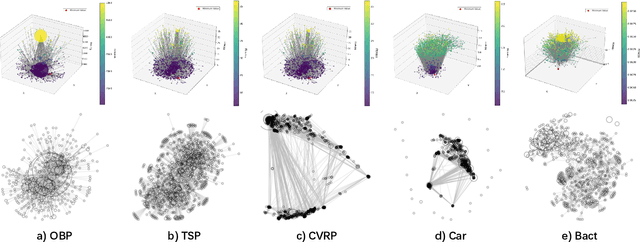
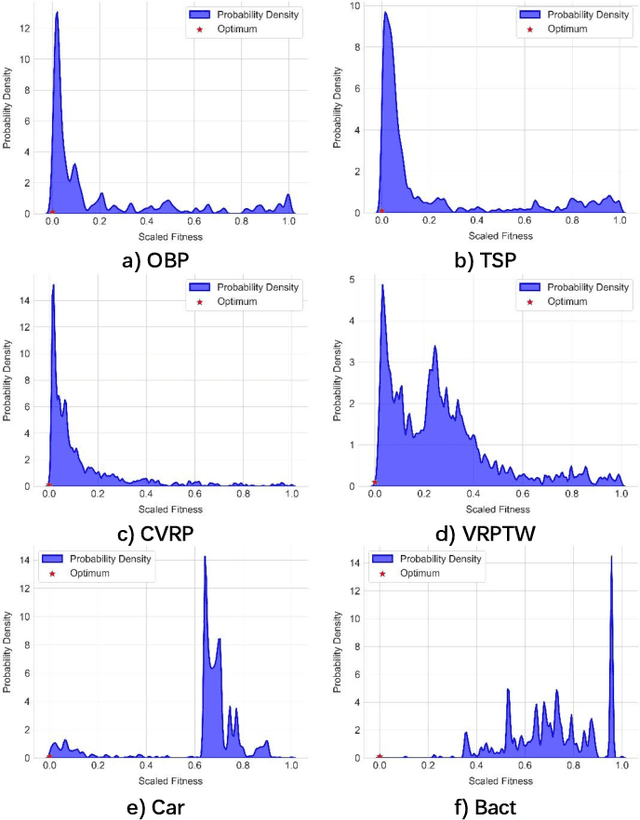
Abstract:Large Language Models (LLMs) have demonstrated significant potential in algorithm design. However, when integrated into search frameworks for iterative algorithm search, the underlying fitness landscape--critical for understanding search behaviou--remains underexplored. In this paper, we illustrate and analyze the fitness landscape of LLM-assisted Algorithm Search (LAS) using a graph-based approach, where nodes represent algorithms and edges denote transitions between them. We conduct extensive evaluations across six algorithm design tasks and six commonly used LLMs. Our findings reveal that LAS landscapes are highly multimodal and rugged, particularly in combinatorial optimization tasks, with distinct structural variations across tasks and LLMs. For instance, heuristic design tasks exhibit dense clusters of high-performing algorithms, while symbolic regression tasks show sparse, scattered distributions. Additionally, we demonstrate how population size influences exploration-exploitation trade-offs and the evolving trajectory of elite algorithms. These insights not only advance our understanding of LAS landscapes but also provide practical guidance for designing more effective LAS methods.
SymRTLO: Enhancing RTL Code Optimization with LLMs and Neuron-Inspired Symbolic Reasoning
Apr 14, 2025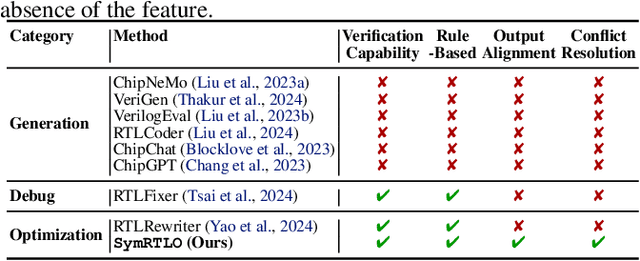


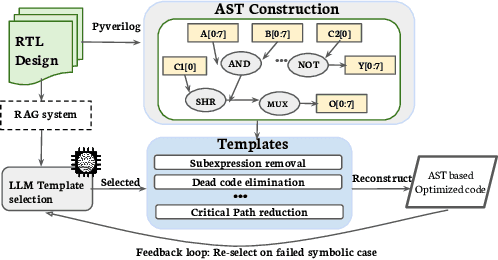
Abstract:Optimizing Register Transfer Level (RTL) code is crucial for improving the power, performance, and area (PPA) of digital circuits in the early stages of synthesis. Manual rewriting, guided by synthesis feedback, can yield high-quality results but is time-consuming and error-prone. Most existing compiler-based approaches have difficulty handling complex design constraints. Large Language Model (LLM)-based methods have emerged as a promising alternative to address these challenges. However, LLM-based approaches often face difficulties in ensuring alignment between the generated code and the provided prompts. This paper presents SymRTLO, a novel neuron-symbolic RTL optimization framework that seamlessly integrates LLM-based code rewriting with symbolic reasoning techniques. Our method incorporates a retrieval-augmented generation (RAG) system of optimization rules and Abstract Syntax Tree (AST)-based templates, enabling LLM-based rewriting that maintains syntactic correctness while minimizing undesired circuit behaviors. A symbolic module is proposed for analyzing and optimizing finite state machine (FSM) logic, allowing fine-grained state merging and partial specification handling beyond the scope of pattern-based compilers. Furthermore, a fast verification pipeline, combining formal equivalence checks with test-driven validation, further reduces the complexity of verification. Experiments on the RTL-Rewriter benchmark with Synopsys Design Compiler and Yosys show that SymRTLO improves power, performance, and area (PPA) by up to 43.9%, 62.5%, and 51.1%, respectively, compared to the state-of-the-art methods.
 Add to Chrome
Add to Chrome Add to Firefox
Add to Firefox Add to Edge
Add to Edge